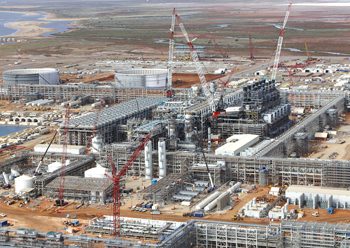Marr’s solutions tackle the challenge
The heavy lifting capacity, diverse choice of products and bespoke solutions offered by Marr Contracting can help address a number of issues faced on industrial sites, says the company which has won international acclaim for its ‘world-firsts’ and record lifts.
01 January 2022
Men from Marr’s (Marr Contracting), a world leader in the design and delivery of heavy lift luffing crane solutions and complex craneage services, says its bespoke solutions are ideally suited to projects such as data centres and giga factory construction, as they aim to reduce the number of lifts and therefore the number of cranes on a project.
“Our approach and track record in pushing the boundaries of what is possible is achieving results for clients in the technology sector,” says a spokesman for the Australia-headquartered company. “By working with the client to fit the crane to the job, and not the other way around, Marr’s solution is always guided by the needs of the client and the project.”
How each craneage solution is shaped depends on the requirements of the job but Marr points out that it is able to provide high-volume construction lifting, maximising the long reach and heavy lift capacity from a single position. The maximum reach is 120 m.
“This brings an increased capability to lift larger precast components such as columns, beams and panels (that is, 330 tonnes at 15 m, 100 tonnes at 45 m, 25 tonnes at 100 m, and 12 tonnes at 120 m). As a result, fewer cranes are needed. This, matched with a small crane footprint, releases laydown and onsite construction areas,” the spokesman explains.
 |
|
Marr’s solutions ... suitable for the construction of data centres. |
The company says its solutions provide contractors the potential to build structural steelwork modules with equipment pre-installed. There is also potential to build precast in part-room or full-room modules, and instal large plant equipment such as diesel generators, water treatment plant and roof steelwork, switchroom equipment, and data-handling and storage equipment.
The benefits for the construction industry include increased productivity with fewer crane lifts, a safer worksite and the ability for project managers to control the critical timeline so that contracts are delivered on time.
“We are constantly looking at how we can add value back into a project and that means looking at how we can improve efficiency and secure the constructor’s schedule,” says Simon Marr, Managing Director of Marr Contracting.
Marr points out that early engagement with the crane expert is the optimal way to plan a construction project, in order to marry construction philosophy with craneage philosophy. However, Marr has extensive experience in being brought into projects where the original crane choices have proven to be less optimal for what the client or constructor wants to achieve.
In those cases, Marr recognises the challenges of retrofitting, while endeavouring to solve the client’s dilemma.
“We have had a few projects where we have been introduced late and the client has already got a construction methodology in place, supported by a less-than-ideal crane methodology. We can still change things and get a result that is better than their current plan, but maybe not as good as if we had been involved at the start. There have been a number of occasions where clients have told us they wish they had known about us earlier,” he adds.
On the plus side, such instances can serve as a learning experience for the client.
Citing an example, Marr elaborates: “One client used traditional crawler cranes for an earlier power plant project with a poor outcome. Since then, they have brought us in early; they have been able to modularise the steel before we were even on site and are already well down the track in their progress. They have the project entirely planned using our cranes.”
“Similar things happened in the oil and gas boom in Australia,” he continues. “On some projects, productivity was poor and delivery slow until the client engaged us. One client commented that when they put our crane to work, in one shift it had done more work than the traditional crawler crane had done in two weeks. For every crane they brought in from us, they took five or six crawler cranes off the job, plus the crews. There were a lot of lessons learned about how we could make the client’s projects more efficient if we were brought in early. The cost savings on that were nothing compared to the cost savings on maintaining their schedule.”
“Not finishing a job on time is expensive. The cost on a project is not the crane – the true cost is every day you are late,” he argues.
Strong & flexible fleet
While Marr has won international acclaim for its ‘world-firsts’ and record lifts, its particular focus is on deploying the right crane for the job. That means being flexible with the choice of crane from the company’s fleet – from the smallest crane, the tiny Marr 40R (M40R), to the world’s largest capacity tower crane, the Marr M2480D Heavy Lift Luffing (HLL) crane.
While the fleet includes mobile and tower cranes for use on high-rise and general construction jobs, it is the crane solutions and the way Marr’s approach a job that sets it apart, the company says.
The flexibility of Marr’s fleet gives the opportunity to deploy tower cranes with a maximum radius reach of 120 m, meaning more parts of the site can be accessed. The ability to fit into a tight footprint is another big asset on crowded projects.
- iLOQ to ‘revolutionise’ locking systems
- Paschal formwork shows its versatility
- Geberit creates added value with eco-design
- Marr’s solutions tackle the challenge
- Pasco Paving Stones boosts Merc-Benz fleet



